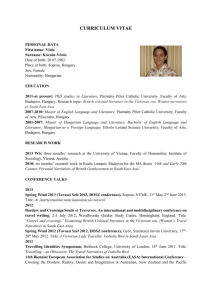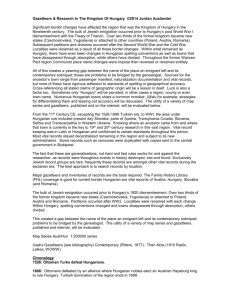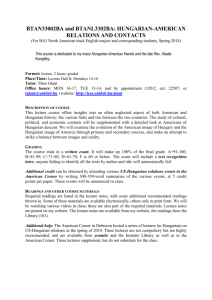Ancient History - Lehigh University
advertisement
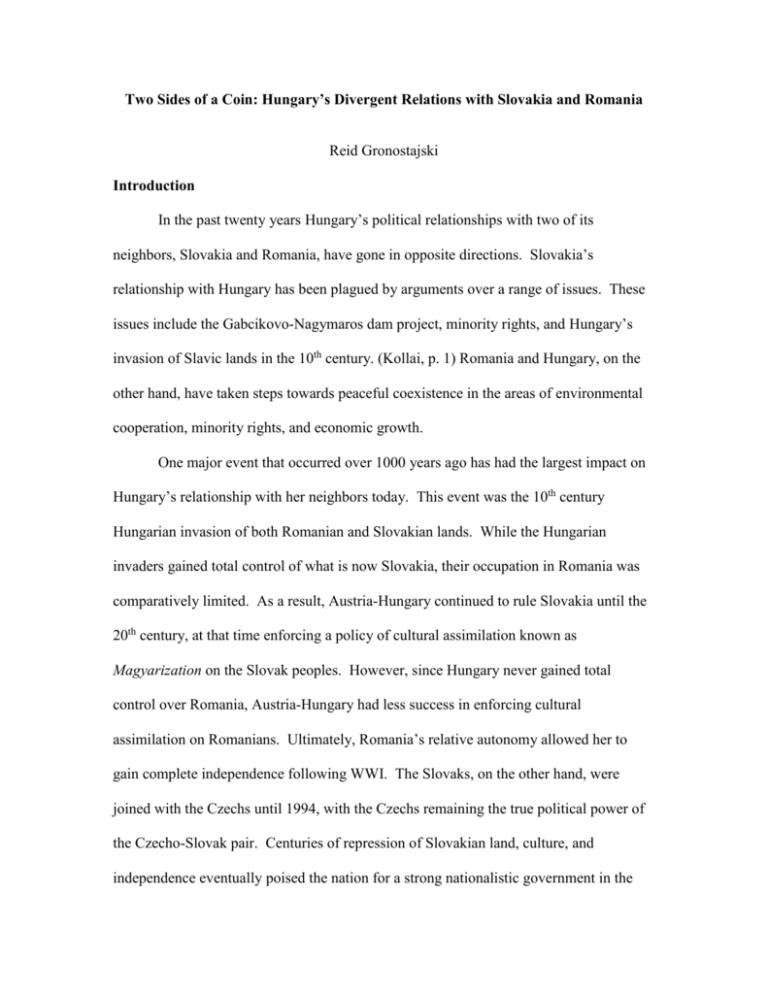
Two Sides of a Coin: Hungary’s Divergent Relations with Slovakia and Romania Reid Gronostajski Introduction In the past twenty years Hungary’s political relationships with two of its neighbors, Slovakia and Romania, have gone in opposite directions. Slovakia’s relationship with Hungary has been plagued by arguments over a range of issues. These issues include the Gabcikovo-Nagymaros dam project, minority rights, and Hungary’s invasion of Slavic lands in the 10th century. (Kollai, p. 1) Romania and Hungary, on the other hand, have taken steps towards peaceful coexistence in the areas of environmental cooperation, minority rights, and economic growth. One major event that occurred over 1000 years ago has had the largest impact on Hungary’s relationship with her neighbors today. This event was the 10th century Hungarian invasion of both Romanian and Slovakian lands. While the Hungarian invaders gained total control of what is now Slovakia, their occupation in Romania was comparatively limited. As a result, Austria-Hungary continued to rule Slovakia until the 20th century, at that time enforcing a policy of cultural assimilation known as Magyarization on the Slovak peoples. However, since Hungary never gained total control over Romania, Austria-Hungary had less success in enforcing cultural assimilation on Romanians. Ultimately, Romania’s relative autonomy allowed her to gain complete independence following WWI. The Slovaks, on the other hand, were joined with the Czechs until 1994, with the Czechs remaining the true political power of the Czecho-Slovak pair. Centuries of repression of Slovakian land, culture, and independence eventually poised the nation for a strong nationalistic government in the 2 1990s. It is this nationalism that has spelled disaster for relations between present day Hungary and Slovakia. Romania, on the other hand, has been less nationalistic and more willing to peacefully negotiate with Hungary. In this article I describe the current relationship between Hungary and Slovakia. I attribute their inability to cooperate as present-day neighbors to historical issues that have existed between the two nations, namely the longstanding Hungarian control of Slovakian land and culture. In contrast, I compare Hungarian and Romanian history to their present relationship in order to highlight a success story. For Romania, a lack of Hungarian control has allowed the two nations to work towards peace in a calm and democratic manner. Finally, I propose solutions to the ongoing Hungarian-Slovakian problem. 21st Century Relations Recently, the governments of Hungary and Romania have taken steps toward cooperation, including holding a joint session on October 20, 2005, during which the “Bridges into the Future” memorandum was discussed and approved. The memorandum includes plans for information technology development, environmental cooperation, and combining of social welfare programs between the two nations. Also covered during this session was a plan for further cross-border projects, such as increasing the number of border crossings and allowing more student communication between the universities of both nations. (“Meeting of Hungarian, Romanian Prime Ministers…,” p. 1) This agreement shows that Hungary and Romania have reached a point of cooperation that will extend into the areas of economics, infrastructure, and the environment. There is significantly less news of cooperative efforts between Hungary and Slovakia, however. In 2005 one of the only joint efforts between the two governments 3 was an effort by their transportation departments to build two bridges across the Ipoly River; only four bridges currently exist. However, since 85 percent of costs will be covered by the EU infrastructure budget (“Hungary, Slovakia to Build…,” p. 1), one wonders whether this act of cooperation is simply an attempt to use allotted EU money or whether it is, in fact, a cooperative effort. To date, no broad memoranda have been signed by the two countries like those signed by Hungary and Romania. The relationship of the Hungarian and Slovakian governments has also been plagued by political bickering. For example, talks between Prime Minister Mikulas Dzurinda of Slovakia and Prime Minister Ferenc Gyurcsany of Hungary in April 2005 were cancelled by Prime Minister Dzurinda when a dispute arose. The dispute occurred when the Hungarian State Secretary mentioned the expulsion of thousands of Hungarians from Czechoslovakia following World War II. The meeting was abruptly called to an end. (“Slovak, Hungarian Leaders Row…,” p. 1) Another recent example of political tension was the sending of a congratulatory letter by Prime Minister Dzurinda on March 19, 2005, to Prime Minister Gyurcsany, lauding the ten year anniversary of the Basic Treaty between Slovakia and Hungary on Good Neighbourly Relations. However, this was the extent of the celebration, as Prime Minister Gyurcsany did not return the congratulations. (“From the Slovak Press,” p. 1) The Basic Treaty was originally meant to ensure the rights of Hungarian minorities living in Slovakia. However, it was passed only when the EU and the U.S. threatened Slovakia’s Prime Minister, Vladimir Meciar, with exclusion from international institutions. This forced friendship between Hungary and Slovakia quickly broke down when the Meciar government passed a law which allowed for only Slavic to be spoken in 4 the border regions. (Goldman, pp. 193-94) Such frequent disagreements have long plagued the governmental relationship between Hungary and Slovakia. Another long-term dispute between the Slovakian and Hungarian governments is over the Gabcikovo-Nagymaros dam, a project which began during the communist era when Hungary and Slovakia agreed to jointly build a hydroelectric dam across the upper Danube. The project was to supply power and flood protection to both countries. With the fall of communism, Hungary abandoned the project, claiming that the dam had been a priority for the former communist government but not the current democratic one. They later justified abandoning the project by finding Hungarian ecologists who argued that the dam project would lower water levels along the Danube, thus destroying the river ecosystem. Slovakian ecologists argued, conversely, that the dam would increase water levels and protect the ecosystem. To this day, each time both sides seem to reach an agreement on finishing the dam, Hungary backs out, using such rhetoric, and Slovakia counters with its own expert sources. (“Slovakia, Hungary Resume Talks...,” p. 1) The dam project has become a political tool, and neither side has been willing to put their own national interests aside to complete the project. (Nagayo, pp. 64-71) The views of the average citizens of each country also correspond to the views of their respective governments. For instance, in a recent survey conducted in the Hungarian/Romanian border regions, people were asked how they characterized their neighbors. Most Hungarians described Romanians as friendly, peaceful, and hard working; Romanians saw Hungarians as productive, honest, and peaceful. Other questions raised by the survey concerned historical events, governmental relations, and cultural differences. (Szabó, p. 36) In answer a large majority of Hungarians and 5 Romanians (62.9 percent and 82.9 percent respectively) agreed that good relations between their governments were an asset. However, 74.3 percent of Hungarians and 36.6 percent of Romanians saw historical events between their countries as a hindrance to future cooperation. (Szabó, pp. 37-39) This reference to historical events refers mainly to past arguments between Hungary and Romania over control of Transylvania. In this case Hungarian citizens recognize that past attempts to invade Transylvania may have had negative consequences on their present day relationship with Romania. Nevertheless, Hungarians and Romanians still have a positive attitude towards each other in the border regions. Conversely, the Hungarians and Slovakians living in the border lands, like their governments, have had their share of skirmishes. For example, on July 15, 2005, in the Slovakian town of Komarno, the Slovak community nationalist group arranged a rally to commemorate a Slovakian national holiday. Hungarians who were visiting the region created animosity by shouting pro-Hungarian slogans during the rally. (“Police Settle Conflict…,” p. 1) Fighting broke out, and two Hungarians were subsequently detained. The relationship between the Slovakian and Hungarian peoples, like that of their governments, is frequently marred by such bickering. Ancient History? To explain the present day disparity between the relationships of Romania and Slovakia with Hungary we must turn to history. In this case, the problems in the Danube region began as early as 895, when the nomadic Magyar (Hungarian) people invaded the land and found it inhabited by Slavic (Slovakian) peoples and Dacians (Romanians). (Lendvai, p. 20) Hungarian historian Szabolcs de Vajay, among many others, views these 6 conquests, which resulted in the formation of the Hungarian nation, with pride and honor. However, other historians such as Jenö Szücs argue that the invasion of the Magyars essentially destroyed much of the political and cultural development of the indigenous peoples. They view the invasion of the Magyars as a tragedy, arguing that it has shaped the present-day politics of the region in a negative way. (Lendvai, pp. 20-21) In rebuttal, Hungarian historians have argued that the Slavs and Dacians were organized into small clans or zhupani that had little or no political organization. However, a group of Romanian historians and archaeologists say that they have found evidence of political entities or voivodates in the region at the time. (Castellan, p. 25) Slovakian historians also found that the kingdom of Great Moravia had governed the Slovakian people and provided a cultural and oral influence that survives to this day. (Kirschbaum, pp. 36-41) These points represent an ongoing argument over the nature of the Magyar invasion. Magyar Controlled Lands Though both Romania and Slovakia continue to argue with Hungary over the nature of the Hungarian invasion, one indisputable difference did develop between Slovakia and Romania in the 10th century. Whereas the region of the Slavic peoples came entirely under the control of the Magyars, the Romanians lost only Transylvania. Because of its proximity to present day Russia and Turkey, Romania had to fend off the Cumans, Tatars, and Ottomans over the centuries, rather than the Hungarians. Due to this fact the voivodates of Wallachia and Moldavia never came under Hungarian control, but rather remained under Romanian control. (Castellan, pp. 26-29) In turn, because of Romania’s long-standing autonomy, the country has been able to suppress or avoid hostile forms of nationalism in later centuries, as will be shown. On the other hand, the 7 Slavic peoples lost all their land to the Magyars following their invasion. This loss of Slovakian lands to the Hungarians ultimately resulted in the creation of an aggressive form of Slovakian nationalism in the 1990s. By leaving the Slovakians in a politically oppressed state for the next 1000 years, Hungary essentially created a situation in which hostile nationalism can flourish. (Kirschbaum, p. 38) The Effects of Magyarization Following the Magyar invasion and for the next nine centuries, Slovakia remained under Hungarian control while Romania continued to fight with Hungary over control of Translvania. (Castellan, p. 97) Not until the end of the 19th century did the next significant event occur, the “Magyarization” or cultural assimilation of the Slavic people in the region. This forcing of the other peoples of the Danube region to forsake their own traditions was one of the major campaigns of the Austro-Hungarian state. Magyarization specifically involved teaching only Magyar language and culture in all Slovakian schools, and excluding Slovakian speakers from government office. (Lendvai, p. 299) For the Slovakians this assimilation was especially devastating due to its historical basis. The Hungarian position was that the Slovakians lived within Hungarian borders, and therefore had no rights. However, as mentioned earlier, the Slovakians never willingly gave up their land, but were forced to do so by Magyar invaders. (Kirschbaum, p. 108) Based on this forced occupation, non-Magyars either had to be assimilated into Magyar culture or be excluded from political activity within Slovakia as well as Hungary. (Kirschbaum, p. 114) As a result of its relative autonomy, Romania was not subjected to the same force of Magyarization during the 19th century. In contrast, Romania was able to achieve full 8 autonomy, as well as a rise in national identity. In fact, as far back as the 18th century the social elite within Romania had begun a nationalist drive within the country, as represented by such books of the period as The Roots of the Daco-Romanian and Short Historical Outline of the Daco-Romanian Nation. These works stressed the ancient origins of Romanians within the Danube region, the result being an increased awareness of Romanian nationality and a subsequent desire to regain complete Romanian independence. (Castellan, pp. 113-14) Ultimately this movement would lead to Romanian independence by recognition of the Congress of Berlin in 1878. The Congress, set up to re-divide the Balkans following the Russo-Turkish war, granted the Balkan states a chance to interject their desires to the European powers. Being that the subject of Romanian independence had been under discussion in Romania for many years prior to the Congress, the Romanians were well prepared to take advantage of these peace talks, and thus were granted independence. (Linden, p. 127) Though culturally oppressed by Hungary, Slovakians did show similar signs of nationalism, with the formation of the Slovak National Council (SNC) in 1848. The SNC was a highly symbolic council that stood for the Slovakian desire for national identity and that attempted to get Slovakian officials elected to office. (Kirschbaum, p. 119) Regardless of these nationalist desires, in 1884 the SNC was unable to get any Slovakians elected to office in Budapest, and subsequently demonstrated electoral passivity for the rest of the 19th century. (Kirschbaum, p. 140) Due mainly to its long history of governance under Hungary, Slovakia was viewed as politically weak, and therefore was unable to fulfill its own political desires through the SNC. At this point one can see that Hungary’s earlier invasion of Slovakia left it in a state of cultural and political weakness, 9 as seen by Magyarization and the powerlessness of the SNC, respectively. At the same time, Romania’s relative autonomy from Hungary allowed it to further its own political and cultural desires during the 18th and 19th centuries, thus widening the gap between the relations of Slovakia and Romania with Hungary. The Widening Relations Gap Romania began World War I as politically neutral, but the presence of Allied encampments in the Hungarian controlled region of Transylvania and a Romanian treaty with the Allied Powers caused Germany to declare war on Romania in 1916. (Castellan, p. 155) After much bloodshed and the conclusion of the war, Romania was able to negotiate the return of Transylvania during peace talks. A delegate of Romania at the time, Take Ionescu gathered supporters to form a National Council of Romanian Unity to address the issue. Through extensive negotiations with the Allied Powers, Ionescu’s council was able to get approval for the creation of Unified Greater Romania on January 11, 1919. (Castellan, pp. 163-64) One reason Romania was able to accomplish this feat was that, as discussed earlier, the Romanian elite had dedicated themselves to the return of Romanian independence. Having this nationalist base enabled Romania to take full advantage of peace talks after World War I. (Castellan, p. 147) Unlike Romania, which gained land after World War I, Slovakia gained neither land nor independence, and became instead a part of Czechoslovakia. While Slovakia was eager to gain autonomy, it was not in a position at the time to become fully independent. Three problems seemed to push the Slovaks toward the decision to join the Czechs: they lacked political organization; the continued oppression of Magyarization led Slovakians to distrust government organizations; and the international community viewed 10 the Slovakians as governmentally weak, especially in light of their lack of interest in holding governmental offices during the late 19th century. For these reasons, it was reasonable to western nations that Slovakia should be grouped with the more politically seasoned Czechs. Slovakia’s agreement to join with the Czechs was an indication of this dependence. (Kirschbaum, pp. 155-59) Again, it is important to note that the continuing divergence between the statuses of Slovakia and Romania in the 20th century has been ultimately a result of Hungary’s long-standing control over Slovakia and relative lack of control over Romania. With a history of oppression under Hungary, Slovakia was in no position to govern herself, something which was not the case in historically autonomous Romania. Nazism and Communism Unlike during the earlier periods mentioned, Hungary, Romania and Slovakia all faced equal hardships under the Third Reich. An agreement to side with Germany was independently made by all three countries, due in part to the protection they thought Germany could provide from Russia. (Castellan, p. 200) In Slovakia’s case the decision to side with Germany was influenced by the fact that the Third Reich granted Slovakia independence from the Czech Republic. However, the permanence of this change was an illusion as Slovakia was rejoined with the Czech Republic following the German defeat. (Goldman, pp. 6-9) In addition, Romania lost much of her Transylvanian lands when they were given to Hungary by Germany. (Castellan pp. 204-205) Due to the fact that these unfortunate outcomes for both Slovakia and Romania could be blamed on Germany, it is unlikely that they caused any observable differences in current relations with Hungary. 11 The period of governance under the Soviet Union, on the other hand, did produce a noticeable outcome in the three countries. Under the overarching power and repression of the Soviet government, interaction between Hungary, Romania, and Slovakia was limited. (Kun, p. 25) Another result was that, due to this repression, fervent nationalism began to grow in the three countries. For instance, Nicolae Ceaucescu, the Romanian dictator from 1965 on, was vehemently anti-Soviet and pro-Romanian. (Tismaneanu, p. 86). Evidence of Slovakian nationalism included attempts by Slovaks to organize a nationalist group, with their goal being to gain some level of political autonomy. (Kirschbaum, pp. 247-48) Hungary, in turn, showed its desire for national independence with the revolution of 1956, during which 2,700 Hungarians died. (Lendvai, p. 453) The nationalism produced by this communist oppression would ultimately provide the spark for future disagreements among the countries of Eastern Europe, especially Hungary, Slovakia, and Romania. For the Slovaks, this nationalist spark has been wielded in the case of Hungarian repression, with decidedly harmful consequences for relations between the two nations. Conversely, Romania’s historic autonomy has allowed it to escape tensions with Hungary, regardless of nationalistic tendencies on both sides. Slovakia Turns the Tide After discussing at length the differing histories of Slovakia and Romania in relation to Hungary, I relate those differences to the way in which they have affected recent relations with Hungary. In the case of Slovakia, one thousand years under cultural, governmental, and territorial control left Slovaks eager for a chance to regain their independence. The results of a 1991 survey showed that an overwhelming 73 percent of Slovaks wanted independence. (Hilde, p. 652) The catalyst for eventual 12 independence came in 1992 when the political party called the Movement for a Democratic Slovakia (HZDS) was formed, leading to Slovakia’s permanent break from the Czech republic in 1994. The first change in Slovakia’s relationship with Hungary came when the HZDS won the largest portion of votes (37.3 percent) in the 1992 parliamentary elections, giving it the largest number of seats (74) of any party in parliament. The HZDS party’s success lay in its role as defender of Slovakia and its focus on Slovakian national identity, an identity which had been historically lacking due to Hungarian oppression. (Haughton, 2001, pp. 746-47) One of the most controversial members of the HZDS was Vladimir Meciar, the elected Prime Minister from 1990-1998. While the importance of the HZDS should not be underestimated, Meciar, above all other members, gave a voice to the concerns of the Slovakians during a confusing time. He frequently referred to himself as the father of the nation, while referring to political rivals as enemies of Slovakia. (Haughton, 2003, pp. 267-69) This highly confrontational nationalism was directed at various sources, especially Hungary. In fact, it was the belief of many HZDS politicians that Hungary’s major agenda was to regain control of Slovakia. (Goldman, p. 187) For this reason, Meciar’s government sought an alliance with “traditional” allies such as Russia. (Linden, p. 138) The Meciar government was characterized by unwillingness to cooperate with its western neighbors and Hungary. Following the election of the HZDS, a second major change was to occur to the Slovakian political landscape. In 1994 Slovakia officially became a fully autonomous state. The decision came as a direct result of the HZDS party being unwilling to accept the new Czech terms of governance after the 1992 elections. However, many historians 13 agree that the real underlying cause of the split was Slovak nationalism, the nationalism supported by the HZDS. (Hilde, pp. 647-48) By the end of the 1990s, Slovakia was in a position of true autonomy and under the control of a strong nationalist party, a combination that has created much tension in Slovakia’s present relationship with Hungary. More importantly, one can see that the HZDS’s nationalist stance has been both justified and fueled by the history of Hungarian oppression. Meciar and the HZDS have successfully used Hungarian oppression as the basis of their political power. Romania’s interaction with Hungary, on the other hand, took a very different turn during the 1990s. The decade began with attacks on Hungarians by Romanians in the Romanian province of Tirgu Mures in March 1990. The attacks were a result of arguments over minority rights in the border regions. In response, both governments adopted a decidedly nationalist stance. Hungarian Prime Minister Antall stated that he was prime minister of fifteen million Hungarians, with five million of them being Romanians living in the border regions. Romania, in turn, replaced Hungarian officials in shared regions of Transylvania with Romanian officials. (Linden, p. 129) Though the two countries would begin the decade with problems, this tense situation soon changed as the decade continued. (Schöpflin, p. 16) Romania’s turning point came when the Party of Social Democracy (PDSR) under the leadership of president Ion Iliescu took majority control of Parliament from 1990 to 1996. (Tismaneanu, p. 91) Much like the HZDS, the PDSR party stressed Romanian nationalism and endorsed returning national independence to Romania. However, the PDSR was also committed to working with its neighbors in Hungary and the West with the aim of political and economic partnership. (Linden, p. 128) Due to a 14 relative lack of Hungarian control exerted over Romania throughout the centuries, Romania’s PDSR was much more willing to cooperate with other nations than was Slovakia’s HZDS. Furthermore, the power held by the PDSR party ensured that any other parties expressing dislike of western integration were weeded out in future elections. (Linden, p. 138) The PDSR’s majority control also allowed president Iliescu to pass more than 800 decrees during his presidency. (Roper, p. 169) It was Iliescu’s Parliamentary-granted presidential power that would ultimately allow him to make a landmark agreement with Hungary. In August 1995, Romanian President Ion Iliescu made the first to attempt to resolve the issue of Hungarian/Romanian arguments over Transylvania by proposing a treaty. Signed by both countries, the basis of the treaty was trust, respect, and the recognition of mistakes made in the past. Specifically, both countries recognized that the arguing over Transylvania should cease and that the nations should instead have shared control over border regions. (Weiner, p. 494) Applying the treaty to minority rights, both countries agreed to grant special status to their Hungarian and Romanian minorities. (“Treaty between the Republic of Hungary…,” p. 1) From this point on, Hungary and Romania have taken other steps toward cooperation, as mentioned earlier. Unlike Slovakia, Romania’s lack of historic tensions with Hungary has allowed her to reach a peaceful resolution. In his article on the issue of current Hungarian/Romanian relations, Ronald Linden (2000) concludes that a number of other factors have contributed to the success of the treaty. First of all, both countries were operating within democratic systems, where cooperative discussion was valued over fighting. In addition, the EU granted 15 considerable incentives to both nations in order that an agreement could be reached. Both countries were anxious to join in the economic prosperity of the West and, therefore, saw their chance in EU integration. Finally, both the Hungarian and Romanian governments were able to keep nationalist agendas in check. (Linden, p. 135) These key factors produced an environment conducive to the formation of the Hungarian/Romanian treaty. At this point one must ask why Hungary and Slovakia could not have reached a similar level in foreign relations, especially in view of the fact that they also signed a 1995 treaty. The EU was also involved in the Hungarian/Slovakian treaty process. Furthermore, both Slovakia and Hungary were democratic nations in the 1990s. The only discernible difference is the stance of the Meciar-led government versus that of the Iliescu-led government. The Slovakian HZDS clearly expressed its dislike of Western integration as well as antipathy toward cooperation with Hungary. (Linden, p. 138) The hostile rhetoric of the Meciar government toward Hungary created a tension that could not be resolved even with a treaty. As mentioned earlier, Romania’s PDSR party was much more willing to work with Hungary and the West. In Linden’s analysis, no clear explanation is given as to why the hostile Meciar government took power in Slovakia while the relatively diplomatic Iliescu government took power in Romania. In this article I have argued that Hungary’s differing level of control over Romania and Slovakia throughout the centuries was in part responsible for producing these two very different governments. Slovakia’s long history of oppression under the Hungarians provides a plausible explanation for the present-day tensions between the two countries. (Goldman, p. 187) This oppression led to the Slovakian desire 16 to elect a government that opposed cooperation with Hungary and sought to protect Slovakian interests, something which was not the case in Romania. Certainly there were many in the governments of Hungary and Romania who opposed mutual cooperation, but the absence of past oppression by Hungary toward Romania allowed Iliescu and the PDSR to achieve peace in a rational and democratic manner, regardless of doubts on both sides. (Weiner, p. 500) Looking Forward A number of solutions have been proposed to ease Hungarian/Slovakian tensions. The first would rely on the shared histories of both nations. Both Hungary and Slovakia have existed side by side for at least 1000 years, suggesting that there must be some social and political similarities. (Kollai, p. 1) Both have experienced national trauma because of the Nazis and communists, but both have emerged as democratic neighbors. The two nations’ joining of the EU has also given them incentives to live up to the following goals of the European Union: (A) desire to deepen the solidarity between their (Europe’s) peoples while respecting their history, their culture and their traditions…[and] a resolve to continue the process of creating an ever closer union among the peoples of Europe. (“Consolidated Version of the Treaty…,” pp. 5-6) Whether through financial incentives or the simple mediation of disputes, Hungary and Slovakia would be well-advised to rely on the assistance of the EU to help solve their problems. However helpful a shared past can be to the dispute, the only real solution is for Hungary and Slovakia to recognize their past and to move beyond the Hungarian oppression of Slovakians. (Kollai, p. 1) Oppression has been the basis of Slovakian 17 hatred of Hungarians for a very long time, and Hungary must formally acknowledge the effects of centuries of oppression on the Slovakian mind. In turn, Slovakia must be willing to recognize Hungary as a nation far removed from its oppressive past. It would be useful to hold a summit meeting including scholars, officials, and citizens of both countries. The goal placed before the summit meeting would be to illuminate what actually happened in the past as well as to understand that the current democratic nations of Hungary and Slovakia are different than their historical counterparts. Romania made such a distinction in its treaty with Hungary with great success. (Linden, p. 135) The only way for the two nations to cooperate is to accept their different pasts but at the same time to move toward a collective future. 18 References Baranyi, Béla, Background Study of the Hungarian-Romanian and The HungarianUkrainian Border Regions. The Debrecen Department of the Great Plain Research Institute of the Centre for Regional Studies. Online. http://www.exlinea.org/pub/background_HU_RO_UA.pdf. Accessed September 8, 2005. Castellan, Georges. A History of the Romanians, New York, NY: Columbia University Press, 1989. “Consolidated Version of the Treaty on European Union.” Online. http://europa.eu.int/eur-lex/en/treaties/dat/C_2002325EN.000501.html. Accessed February 3, 2006. “From the Slovak Press.” Czech News Agency. March 21, 2005. Online. http://web.lexisnexis.com/universe/document?_m=5fc7c03716659eb383bc6ff3240b47ad&_docn um=10&wchp=dGLbVlb-zSkVb&_md5=da49dbc21856bfbe7f4a03d053c60808. Accessed September 8, 2005. Goldman, Minton F. Slovakia since Independence: A Struggle for Democracy, Westport, CT: Praeger Publishers, 1999. Haughton, Tim. “Facilitator and Impeder: The Institutional Framework of Slovak Politics during the Premiership of Vladimir Meciar.” The Slavonic and East European Review, Vol. 81, No. 2, April 2003, pp. 267-90. Haughton, Tim. “HZDS: The Ideology, Organisation, and Support Base of Slovakia’s Most Successful Party.” Europe-Asia Studies, Vol. 53, No. 5, July 2001, pp. 74569. Hilde, Paul Sigurd. “Slovak Nationalism and the Break-Up of Czechoslovakia.” EuropeAsia Studies, Vol. 51, No. 4, June 1999, pp. 647-65. “Hungary, Slovakia to Build Two More Bridges over Ipoly River.” Hungarian News Agency. October 19, 2005. Online. http://web.lexisnexis.com/universe/document?_m=9999bca8a2a8fcc12ee7a33964f87475&_docn um=1&wchp=dGLbVlb-zSkVb&_md5=01bf4f579a84a84c3d1bac9c412c21d4. Accessed December 6, 2005. Kirschbaum, Stanislav L. A History of Slovakia: The Struggle for Survival, New York, NY: St. Martin’s Press, 1995. Kollai, Istvan “Slovakian-Hungarian Reconciliation. Twelve Points” Reinventing Central Europe. May 13, 2005. Online. http://www.talaljukki.hu/index.php/article/articlereview/169/1/63. Accessed September 20, 2005. 19 Kun, Joseph C. Hungarian Foreign Policy: The Experience of A New Democracy, Westport, CT: Praeger Publishers, 1993. Lendvai, Paul. The Hungarians: A Thousand Years of Victory in Defeat, Princeton, NJ: Princeton University Press, 2003. Linden, Ronald H. “Putting on Their Sunday Best: Romania, Hungary, and the Puzzle of Peace.” International Studies Quarterly, Vol. 44, No. 1, March 2000, pp. 121-45. “Meeting of Hungarian, Romanian Prime Ministers Yields 15 Agreements.” Hungarian News Agency. October 20, 2005. Online. http://web.lexisnexis.com/universe/document?_m=f794bd571d8b58aaffb28029f45ccfaa&_docnu m=1&wchp=dGLbVtb-zSkVb&_md5=edbd41b01b16ab6be9e3106cb86d44d6. Accessed December 6, 2005. Nagayo, Susumu. “Slovakia and Hungary: The Most Complicated Bilateral Relations in Central Europe: Focusing on the Gabčíkovo-Nagymaros Problem.” Slavic Research Center. February 18, 2004. Online. http://srch.slav.hokudai.ac.jp/sympo/96summer/nagayo.pdf. Accessed December 6, 2005 “Police Settle Conflict between Slovaks, Hungarians in Komarno.” Czech News Agency. July 5, 2005. Online. http://web.lexisnexis.com/universe/document?_m=586c5cd95026c1bf0a36272dba78e910&_docn um=1&wchp=dGLbVlb-zSkVb&_md5=197f2ec327d2ad9a4a8782a1c6bcc7c5. Accessed September 8, 2005. Roper, Steven D. “Parliamentary Development,” in Romania since 1989: Politics, Economics, and Society. Henry F. Carey, ed. New York, NY: Lexington Books, 2004. Schöpflin, George. Hungary and Its Neighbours. The Institute for Security Studies of WEU. May 1993. Online. http://www.iss-eu.org/chaillot/chai07e.html. Accessed September 6, 2005. “Slovak, Hungarian Leaders Row over WWII.” United Press International. April 15, 2005. Online. http://web.lexisnexis.com/universe/document?_m=ceb963a0a9effa8ed64d67e68c7444ca&_docn um=8&wchp=dGLbVlb-zSkVb&_md5=8c54628d10e4de274baf8b1359ed493f. Accessed September 8, 2005. “Slovakia, Hungary Resume Talks on Gabcikovo Project.” Czech News Agency. April 13, 2004. Online. http://web.lexisnexis.com/universe/document?_m=39bdcd1a08ddcb9b7af8188ef7399539&_docn um=1&wchp=dGLbVtb-zSkVb&_md5=8db89c26045f9195de1de9275c9d8954. Accessed February 3, 2006. 20 Szabó, Gyula. “Findings of the Questionnaire Survey along the Hungarian-Romanian and the Hungarian-Ukrainian Border.” Lecture presented March 3-4 2005, at the CRS of HAS Debrecen Department. Online. http://www.exlinea.org/pub/Hu-ukrro_resultse_march05.pdf. Accessed September 8, 2005. Tismaneanu, Vladimir. “The Revival of Politics in Romania.” Proceedings of the Academy of Political Science, Vol. 38, No. 1, 1991, pp. 85-99. “Treaty between the Republic of Hungary and Romania on Understanding, Cooperation and Good Neighborhood.” Online. http://archiv.meh.hu/nekh/Magyar/7/asz-roe.htm. Accessed February 3, 2006. Weiner, Robert. “Romanian Bilateral Relations with Russia and Hungary: 1989-2002,” in Romania since 1989: Politics, Economics, and Society. Henry F. Carey, ed. New York, NY: Lexington Books, 2004.
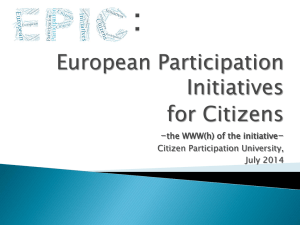
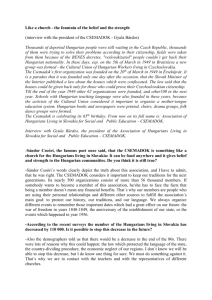


![View full document [DOC 121.00 KB]](http://s3.studylib.net/store/data/007311467_1-d846f7b116a73f74023d7a29ba436503-300x300.png)
